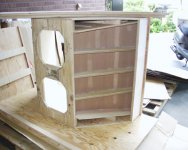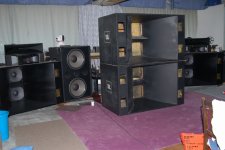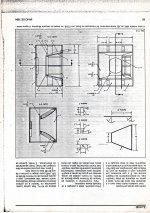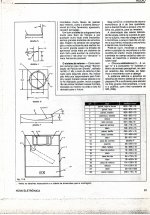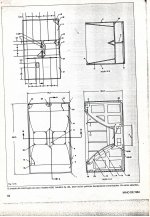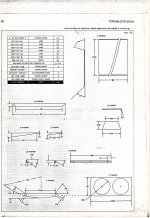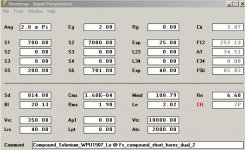Hi all. After exhaustive searches to find plans for the JBL 4550A or 4550BKA, I got interested in modeling my own variant using Hornresp. With the help of people on this forum, other websites, and my Father who is a world-class engineer, I've become at least a little knowledgeable on horns, drivers, and tuned circuits. I now believe that I'm entering the "home stretch" of my design of a JBL 4550A copycat.
My current design consists of two JBL 2226J drivers, and differs from the 4550A in that I have no phasing plug (I believe that's what you'd call the thing in the middle of the 2 drivers in the 4550A), and the vent would be a single vent which would ride underneath the cabinet, rather than out to the sides. To this end, I have a few questions:
1) How do I model the vents in the JBL 4550A, which seem to be simple cut-outs in the side of the box, in Hornresp? To me, the 4550A looks like it simply wraps the rear chamber around to the side and just vents at the ends of the chamber, which should be perfectly "legal" with regard to horn theory, so long as the front-to-back length ("Lrc" in Hornresp) stays consistent, right? So to model this, should I specify Lpt = the wood thickness (0.75" = 1.905cm)? Or should I make Lpt equal to 1.905 times the number of vents?
2) I've noticed only extremely marginal improvements in the low-end response while playing with various parameters, like the chamber volume, the vent size, vent depth, etc. Changing vent parameters and the chamber volume seems to create a "hole" in the SPL graph somewhere below 30hz, however I can get rid of that hole by tweaking those parameters. But overall, I'm not seeing the kind of additional SPL by using a port as I would expect (I've compared to a sealed box - they're basically the same). What am I doing wrong? What should I expect out of a vent versus a sealed design? And since they seem to be the same (from what I can see) why do I care about vents anyway?
3) The thing in the middle of the drivers that I was referring to - what is its purpose? Is it a phasing plug as I supposed? What advantage does its presence have? How can I model one in Hornresp?
I'll send my Hornresp parameters if necessary; I'm also attaching a couple pictures of a 4550A for reference - one is JBL, the other is a homebrew variant by a guy in Japan (wish I could get an email address for him...) which depicts the construction of these things as best I know it. Thanks in advance!
My current design consists of two JBL 2226J drivers, and differs from the 4550A in that I have no phasing plug (I believe that's what you'd call the thing in the middle of the 2 drivers in the 4550A), and the vent would be a single vent which would ride underneath the cabinet, rather than out to the sides. To this end, I have a few questions:
1) How do I model the vents in the JBL 4550A, which seem to be simple cut-outs in the side of the box, in Hornresp? To me, the 4550A looks like it simply wraps the rear chamber around to the side and just vents at the ends of the chamber, which should be perfectly "legal" with regard to horn theory, so long as the front-to-back length ("Lrc" in Hornresp) stays consistent, right? So to model this, should I specify Lpt = the wood thickness (0.75" = 1.905cm)? Or should I make Lpt equal to 1.905 times the number of vents?
2) I've noticed only extremely marginal improvements in the low-end response while playing with various parameters, like the chamber volume, the vent size, vent depth, etc. Changing vent parameters and the chamber volume seems to create a "hole" in the SPL graph somewhere below 30hz, however I can get rid of that hole by tweaking those parameters. But overall, I'm not seeing the kind of additional SPL by using a port as I would expect (I've compared to a sealed box - they're basically the same). What am I doing wrong? What should I expect out of a vent versus a sealed design? And since they seem to be the same (from what I can see) why do I care about vents anyway?
3) The thing in the middle of the drivers that I was referring to - what is its purpose? Is it a phasing plug as I supposed? What advantage does its presence have? How can I model one in Hornresp?
I'll send my Hornresp parameters if necessary; I'm also attaching a couple pictures of a 4550A for reference - one is JBL, the other is a homebrew variant by a guy in Japan (wish I could get an email address for him...) which depicts the construction of these things as best I know it. Thanks in advance!
Attachments
They're main purpose as I see it is to control displacement near the LF-cutoff of your cabinet so you can get the power up to the coil heat limit. Frequency response be damned! We want it loud for PA...why do I care about vents anyway?
Nice pix by the way.
The pics aren't mine.. I got them via google image search. But the Japanese do seem to love those 4550A's.
I'm having a hard time with your explanation. I'll concede that you *can* do that with the vent, as I've modeled in this fashion before (though I'm not clear on the mechanics behind it all). But every bit of reading I've done on horn theory suggests that the benefit of a vented front-loaded horn is that the vent becomes phase-additive with the output of the horn, and extends the LF response. Indeed this seems to be confirmed by Altec 817 literature, wherein they purport "Design of the front-loading enclosure loads the bass driver down to 150hz; the bass reflex porting extends the response to 50hz and lower when multiple units are used. I presume they mean that a single cabinet does 50hz in half-space - quite easy to believe - and that multiple cabs in parallel go lower because of the wider Q. See http://www.altecpro.com/pdfs/vintage/SpeakerAndMics/cabinets/817A LF Speaker Cabinet.pdf if you care to see what I'm reading from.
So what gives? What do the so-called "experts" on horn design have to say about it?
I'm having a hard time with your explanation. I'll concede that you *can* do that with the vent, as I've modeled in this fashion before (though I'm not clear on the mechanics behind it all). But every bit of reading I've done on horn theory suggests that the benefit of a vented front-loaded horn is that the vent becomes phase-additive with the output of the horn, and extends the LF response. Indeed this seems to be confirmed by Altec 817 literature, wherein they purport "Design of the front-loading enclosure loads the bass driver down to 150hz; the bass reflex porting extends the response to 50hz and lower when multiple units are used. I presume they mean that a single cabinet does 50hz in half-space - quite easy to believe - and that multiple cabs in parallel go lower because of the wider Q. See http://www.altecpro.com/pdfs/vintage/SpeakerAndMics/cabinets/817A LF Speaker Cabinet.pdf if you care to see what I'm reading from.
So what gives? What do the so-called "experts" on horn design have to say about it?
There is a 6dB shelf in the response of these type of cabinets, about 160hz on the 4560 (single 15 version of the 4550).
Best use of 4560 type cabinets:
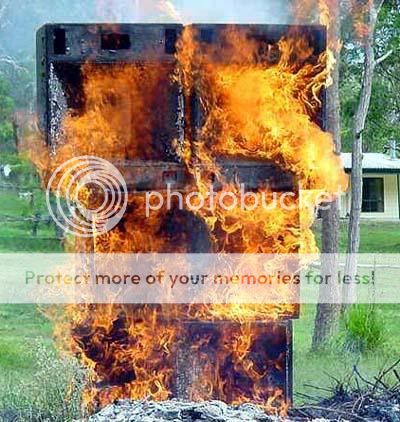
Why do you want to build 4550s? The 2226 is not a very good driver for them. The 2220 allows them to reach 500hz, the mass corner of the 2226 is half that.
(with the correct drivers) These kind of boxes were fine for the old SMPTE standard, a two-way with a 500hz crossover point. Of the big three (Altec A4, JBL4550, RCA Ubangi), the 4550 was kind of in the middle performance wise, the RCA had much better midrange. None of these had any 'real' bass.
Best use of 4560 type cabinets:

Why do you want to build 4550s? The 2226 is not a very good driver for them. The 2220 allows them to reach 500hz, the mass corner of the 2226 is half that.
(with the correct drivers) These kind of boxes were fine for the old SMPTE standard, a two-way with a 500hz crossover point. Of the big three (Altec A4, JBL4550, RCA Ubangi), the 4550 was kind of in the middle performance wise, the RCA had much better midrange. None of these had any 'real' bass.
Best use of 4560 type cabinets:

*nod*
Why do you want to build 4550s? The 2226 is not a very good driver for them. The 2220 allows them to reach 500hz,
It started out as my father's quest to find me some serious decibels.. my JBL 4412A's run out of gas around 117db, thereabouts. This system (with my 2447-based horns) will do an easy 130db. The 2226J's are 16 ohms (awesome for precise excursion control) and are commercially available. They'll handle 600 watts, so very conducive to giving me the SPL I'm looking for, and even better when used in a horn. I haven't looked at a lot of drivers, but I've looked at a few.. the 2226's seem to be a good happy medium of Fs, power handling, and Q. As for reaching 500hz, my present incarnation has them at +-3db between 45hz and 650hz into quarter-space (which will be my listening environment). It seems almost perfect for my tastes.
the mass corner of the 2226 is half that.
I'm not familiar with that term.
None of these had any 'real' bass.
In my environment, the bass response looks pretty real to me. I'll let everyone know how they measure out.
There is a 6dB shelf in the response of these type of cabinets, about 160hz on the 4560 (single 15 version of the 4550).
Best use of 4560 type cabinets:

The main problem with these enclosures is crazy phase response (and group delay). Frequency response is not as narrow or as uneven as it could appear, but the problem is making them sum with anything else both on top and on bottom (a headache for any crossover designer). Scoop type cabinets have the same problem if they are used with mid horns.
hey i got a pair of giants very much like those, in my garage. they have long vertical slots in the far right and left sides, instead of the square holes, cut for stacked 15s like those. whats interesting (i think) is they have a (fiberglass dual horn insert) and heavy duty fiberglassed woood houseing, wheels and handles, very difficult to move, and barely squeeze (with kicking and cussing) through a 3/0 door, ill try to get pix up
Yea I'd very much look forward to pics of those. What you're describing is very similar to what I already had in mind - add removable wheels attached via T-nuts on the bottom, and handles on the side. All panels would be reinforced by epoxy and wood doublers on the inside, both at the joints and along the panels. The vertical slits that you describe are similar to the Altec 817 cabinets, which incidentally is how i'll be building these. I tried desperately to make a pair of Altec 816s (single driver front-loaded horns) work with similar results as the 817/4550a style horns - they just don't. Using the "multiple speaker" wizard in Hornresp, dual stacked 816s are still 5db lower at 40hz, and 5db lower at 600hz (crossover frequency) than the dual cabinet version. So I'm pretty settled on this style.
The only thing yet to be determined is whether I should make them slightly bigger on their external dimensions, and use a removable driver section so I can accommodate some Eminence 18's in the future They're a full 6db higher at 40hz than the 2226's, with barely a 1.4db increase in input power (as a result of the lower coil impedances). Their output at the crossover frequency is within 0.5db of the JBLs, but with the added low-end. mmmmmm. decisions decisions.
They're a full 6db higher at 40hz than the 2226's, with barely a 1.4db increase in input power (as a result of the lower coil impedances). Their output at the crossover frequency is within 0.5db of the JBLs, but with the added low-end. mmmmmm. decisions decisions.
The only thing yet to be determined is whether I should make them slightly bigger on their external dimensions, and use a removable driver section so I can accommodate some Eminence 18's in the future
Hi letsbangout,
For a while there was some real interest in the compound horn enclosures, enclosures having a short front horn, and a large rear bass reflex enclosure. These enclosures are quite driver specific, you can't just stuff any old driver in there, and expect any positive results. The good thing is that compound enclosures can be modeled in Hornresp, I'll attach an example. Also, you may google for "artec france onken" for some examples and drawings.
Regards,
For a while there was some real interest in the compound horn enclosures, enclosures having a short front horn, and a large rear bass reflex enclosure. These enclosures are quite driver specific, you can't just stuff any old driver in there, and expect any positive results. The good thing is that compound enclosures can be modeled in Hornresp, I'll attach an example. Also, you may google for "artec france onken" for some examples and drawings.
Regards,
Attachments
- Status
- This old topic is closed. If you want to reopen this topic, contact a moderator using the "Report Post" button.
- Home
- Loudspeakers
- Subwoofers
- Modeling the JBL 4550
